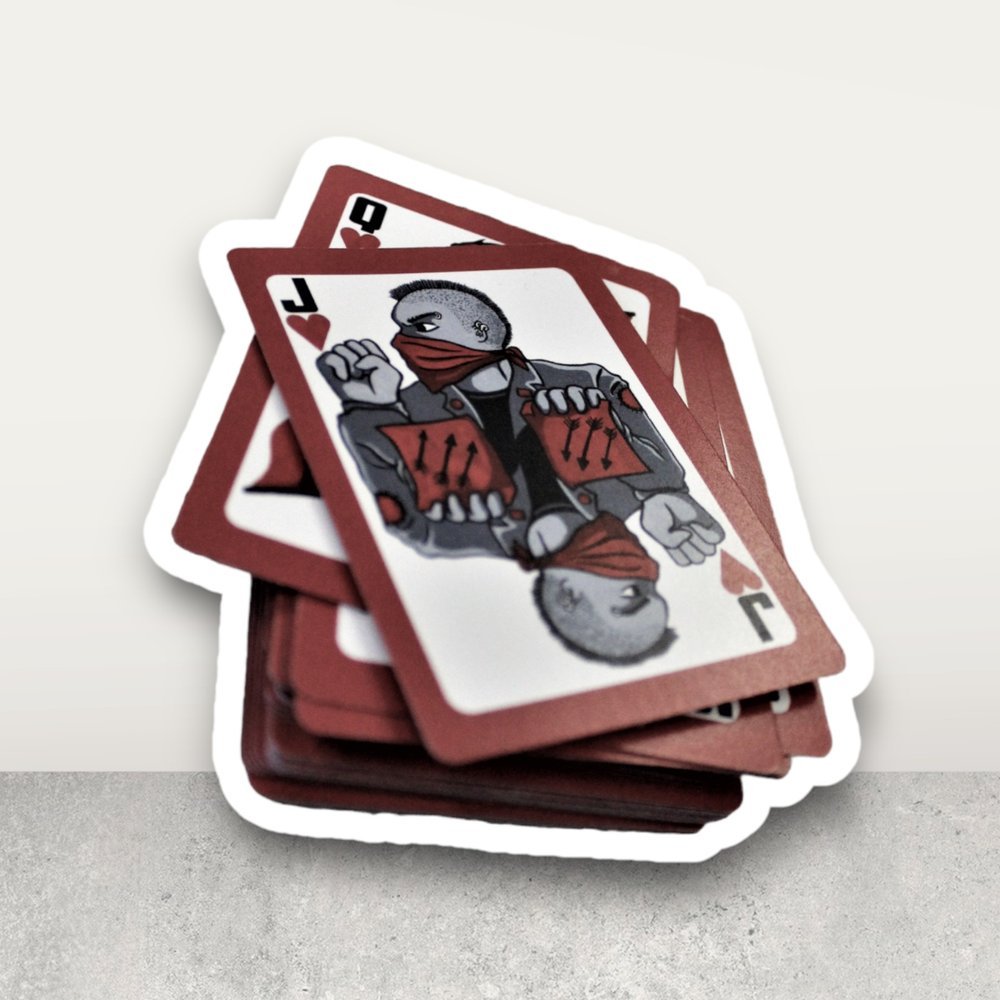Behind the scenes of "The Generalissimo is Dead" - A megagame journey
Ciaran helps run True North Megagames up beyond the wall in the UK and designed The Generalissimo is Dead. Read on to see how the run went and where you can buy a copy of the game to run yourself.
He's irreplaceable. How can we possibly...?
Greetings, fellow megagame enthusiasts! I am Ciaran O'Sullivan, the designer behind the cunning conspiracy generator "The Generalissimo is Dead." Today, I'm excited to share with you the design process and inspirations that shaped this unique megagame, inspired by the Death of Stalin and the power vacuums left in the wake of a succession crisis. Join me as we take a peek behind the curtain and explore the intricacies of its creation.
The Spark of Inspiration
Every great megagame begins with a spark of inspiration, and "The Generalissimo is Dead" was no exception; in this case the fantastic and irreverent film "The Death of Stalin" by Armando Iannucci. Iannucci is a gifted director who is particularly skilled at capturing the unique drama that characterizes political manoeuvring. His series "The Thick of It" has only become more relevant and accurate as time has passed in British politics. The backdrop of Stalin's demise and the ensuing power struggles among the Soviet elite intrigued me immensely.
The challenge lay in capturing the essence of that era while providing players with an immersive experience that would transport them to a world of political intrigue and high-stakes decision-making. As I lay in bed the night after watching the film the game sprang to life in my mind. I knew I wanted a game where every part of the Soviet state's political machinery could impact what happens. There is something particularly enthralling about how much history is shifted due to train rescheduling. For this, I knew I wanted game mechanics that could handle a wide variety of actions and influences as an integrated whole rather than a collection of separate systems. I also knew I didn’t want to constrain myself to a purely historical perspective.
Solving these two problems brought “The Generalissimo is Dead” to life.
Designing a Universal Resolution System
One of my primary goals as a designer was to ensure that "The Generalissimo is Dead" was accessible to players of all experience levels, yet mechanically satisfying enough that all decisions felt meaningful. With this in mind, I pondered over various resolution systems that would be intuitive yet offer strategic depth. Eventually, I settled on using regular playing cards as the game's universal resolution system
I designed the game around the basic deck of cards - 4 suits, 13 cards each with 2 Jokers. Initially, I intended to build the game around Poker hands, but that proved to be complicated to explain and limited the flexibility of the cards. I needed something simpler, that made decision-making quick and resolution easy.
Each suit was designed to represent a different aspect of the game:
Clubs - Enforcement - the ability of the government to exert force and law & order
Hearts - Will - the ability of the government to rally the political will to make a decision
Diamonds - Capital - the ability of the government to be able to pay for things
Spades - Manpower - finding the staff to work on a given task within the tight timescales of the game
Combining these 4 suits covered the main things a budding member of a dictatorial regime would need to marshall to enact their will. Want to organise extra trains for the Generalissimo’s Funeral? Better have the Manpower to do so. Want to organise police to handle the massive influx of crowds? Better have sufficient Enforcement and Political Will to handle the situation.
When it came to designing the cards I worked with @MysteriousCube who came up with the idea that the Generalissimo would embody the King of each suit - as father of the nation what role has he not accomplished? The Queen and Jack of each deck to be representative of a political class linked to that deck:
Clubs - Soldiers and Police
Hearts - Revolutionaries
Diamonds - Financiers and Capitalists
Spades - Workers
They defined the art style, based on both traditional playing cards and Soviet-era propaganda. This design was carried throughout the departmental logos, with a strong focus on red and black with a motif of hands found within revolutionary imagery. The biggest challenge proved to be the process of gauche painting the Generalissimo’s many, many medals in excruciating detail for each suit.
Once I had the cards designed I decided to base the entire game around players trying to enact policies either with the approval of the Central Committee or behind the backs of the Party Leaders. Every mechanical action the players could take was based on these policies - a policy could be about raising the price of apples or it could be about ordering a coup d’etat.
The difficulty of each policy was dictated by the impact it would have. This mechanic was central to the whole game, as it meant that all actions taken in the game had an element of collaboration. Players needed to work together and negotiate and conspire to accomplish their goals. There was still plenty of room for mischief and individual freedom, but the main theme was collaboration.
Welcome to Yugenya
I knew I didn’t want to make a purely historical megagame. There were a number of reasons for this:
Soviet Russia was at times a despicable and ugly place. Beria is utterly horrid both as a character in “The Death of Stalin” and in real life. Even in a dark comedy, it’s pretty dark.
A fake country gave me more narrative space to talk about things not specifically related to the USSR and Stalin.
I took inspiration from “Yes Minister” - another great piece of political satire when coming up with the name “Yugenya”, and I even referenced Buranda as Yugenya’s neighbouring rival. The name sounds ambiguously like a country that could be in the Middle East (Yemen), Africa (Kenya) or Eastern Europe (Yugoslavia). As I answered the question anytime it came up in the game “Yugenya is exactly where it needs to be”.
The main driving factor behind many revolutionary/dictatorial regimes is that they have a source of wealth they control, and usually well-developed infrastructure related to the extraction of that wealth and all power tends to be centralised around that infrastructure. This simplified any sort of coup attempts anyone might be planning - there are only so many possible things that will affect the nation.
Diving into Gameplay Mechanics
Designing the gameplay mechanics was a delicate balancing act. The heart of the game revolved around faction asymmetry, where each player worked within their ministry and had limited remits within the Yugenyan elite. I strived to create diverse factions, each with its own resources, and objectives, ensuring that players could fully immerse themselves in their roles.
Diplomacy and alliances played a pivotal role in "The Generalissimo is Dead." I wanted to encourage players to engage in cunning negotiations, forming alliances to strengthen their positions or betraying them for personal gain. The dynamics of trust and betrayal added a layer of intrigue, creating a tense and immersive experience. It was an important facet of the day that players were in a team with their ministry to an extent, but they were not united in all things. Certain teams like the Treasury were often fundamentally split on their core function - make money or maintain the status quo.
Random events also played a crucial role in shaping the game's narrative. These events were only slightly random, as the State of the Nation played a big part in informing control about how the Nation of Yugenya was reacting to the news that the Generalissimo had died. This added an element of adaptability and challenged players to think on their feet.
The State of the Nation mechanics were a series of graphs that all policy and ministerial decisions fed into. This one central display of the key features of the country - availability of budget, how mobilised the armed forces are, whether the police are repressing the populace etc. meant you could tell at a glance how Yugenya was doing, and many policies required the country be in a specific state before they could be enacted - you can’t order new fighter jets if you don’t have room in the national budget.
These mechanics, alongside additional rules for arrests, coups, plots and popular elections have resulted in a very satisfying game each time it has been run. Although the briefings and attendees have changed each run, the game plays out true to its source material. I live in fear of the game running and the players enacting a successful and respectful succession!
Passed… Unanimous….ly
"The Generalissimo is Dead" was a labour of love, combining historical inspiration with straightforward gameplay mechanics to create an engaging and unforgettable megagame experience. As a designer, I learned the value of simplicity, by stripping back the mechanical elements and removing superfluous random elements like dice, the player's actions become the defining element behind the events of the game. The nature of players results in more chaos than any fog of war ever could.
I hope that "The Generalissimo is Dead" will leave a lasting impression on those who participate, as they navigate the treacherous waters of Yugenyan politics and strive for ultimate power in the wake of the Generalissimo’s demise. Thank you for joining me on this journey, and I look forward to witnessing the unfolding drama as new players explore the world I have crafted.
The Generalissimo is Dead is now available on itch.io for purchase for other groups to organise and run.
Thanks to Ciaran for writing about creating ‘The Generalissimo is Dead‘ - if you have a megagame story you want to tell the world, let us know.





